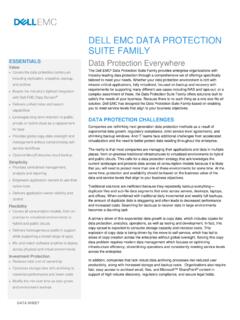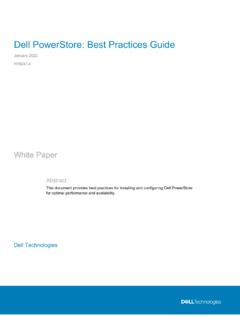Transcription of Dell EMC Isilon: A Technical Overview - USC Digital Repository
1 white paper dell EMC isilon ONEFS: A Technical Overview ABSTRACT This white paper details how the isilon OneFS architecture provides high availability and data protection needed to meet the challenges organizations face as they deal with the deluge of Digital content and unstructured data and the growing importance of data protection. April 2017 2 TABLE OF CONTENTS INTRODUCTION ..3 ONEFS Overview ..3 isilon nodes .. 4 Network .. 4 IsilonSD Edge Software Defined OneFS .. 5 OneFS software Overview .. 5 File system structure .. 8 Data layout .. 9 OneFS Caching .. 14 ONEFS CACHE COHERENCY .. 16 Level 1 Cache .. 16 Level 2 Cache .. 17 Level 3 Cache .. 17 Data protection.
2 22 Node Compatibility .. 28 Supported protocols .. 29 Non-disruptive Operations - Protocol Support .. 30 File Filtering .. 30 Data Deduplication - SmartDedupe .. 30 Storage optimization for Medical PACS .. 32 Authentication and access control .. 33 Access zones .. 34 Roles Based Administration .. 34 OneFS Auditing .. 34 Software upgrade .. 35 isilon DATA PROTECTION AND MANAGEMENT SOFTWARE .. 35 CONCLUSION .. 36 3 Introduction Seeing the challenges with traditional storage architectures, and the pace at which file-based data was increasing, the founders of isilon Systems developed a revolutionary new storage architecture the OneFS Operating System. The fundamental difference of dell EMC isilon storage is that it uses intelligent software to scale data across vast quantities of commodity hardware, enabling explosive growth in performance and capacity.
3 The three layers of the traditional storage model file system, volume manager, and data protection have evolved over time to suit the needs of small-scale storage architectures, but introduce significant complexity and are not well adapted to petabyte-scale systems. dell EMC isilon OneFS replaces all of these, providing a unifying clustered file system with built-in scalable data protection, and obviating the need for volume management. OneFS is a fundamental building block for scale-out infrastructures, allowing for massive scale and tremendous efficiency. Crucially, OneFS is designed to scale not just in terms of machines, but also in human terms allowing large-scale systems to be managed with a fraction of the personnel required for traditional storage systems.
4 OneFS eliminates complexity and incorporates self-healing and self-managing functionality that dramatically reduces the burden of storage management. OneFS also incorporates parallelism at a very deep-level of the OS, such that virtually every key system service is distributed across multiple units of hardware. This allows OneFS to scale in virtually every dimension as the infrastructure is expanded, ensuring that what works today, will continue to work as the dataset grows. OneFS is a fully symmetric file system with no single point of failure taking advantage of clustering not just to scale performance and capacity, but also to allow for any-to-any failover and multiple levels of redundancy that go far beyond the capabilities of RAID.
5 The trend for disk subsystems has been slowly-increasing performance while rapidly-increasing storage densities. OneFS responds to this reality by scaling the amount of redundancy as well as the speed of failure repair. This allows OneFS to grow to multi-petabyte scale while providing greater reliability than small, traditional storage systems. isilon scale-out NAS hardware provides the appliance on which OneFS executes. Hardware components are best-of-breed, but commodity-based ensuring that isilon hardware benefits from commodity hardware s ever-improving cost and efficiency curves. OneFS allows hardware to be incorporated or removed from the cluster at will and at any time, abstracting the data and applications away from the hardware.
6 Data is given infinite longevity, protected from the vicissitudes of evolving hardware generations. The cost and pain of data migrations and hardware refreshes are eliminated. OneFS is ideally suited for file-based and unstructured Big Data applications in enterprise environments including large-scale home directories, file shares, archives, virtualization and business analytics. As such, OneFS is widely used in many data-intensive industries today, including energy, financial services, Internet and hosting services, business intelligence, engineering, manufacturing, media & entertainment, bioinformatics, scientific research and other high performance computing environments.
7 OneFS Overview OneFS combines the three layers of traditional storage architectures file system, volume manager, and data protection into one unified software layer, creating a single intelligent distributed file system that runs on an isilon storage cluster. Figure 1: OneFS Combines File System, Volume Manager and Data Protection into One Single Intelligent, Distributed System. 4 This is the core innovation that directly enables enterprises to successfully utilize the scale-out NAS in their environments today. It adheres to the key principles of scale-out; intelligent software, commodity hardware and distributed architecture. OneFS is not only the operating system but also the underlying file system that drives and stores data in the isilon scale-out NAS cluster.
8 isilon nodes OneFS works exclusively with the isilon scale-out NAS nodes, referred to as a cluster . A single isilon cluster consists of multiple nodes, which are rack-mountable enterprise appliances containing: memory, CPU, networking, Ethernet or low-latency Infiniband interconnects, disk controllers and storage media. As such, each node in the distributed cluster has compute as well as storage or capacity capabilities. With isilon s new Gen6 hardware platform, a single chassis of 4 nodes in a 4U form factor is required to create a cluster, which currently scales up to 144-nodes. Previous isilon hardware platforms need a minimum of three nodes and 6U of rack space to form a cluster.
9 There are several different types of nodes, all of which can be incorporated into a single cluster, where different nodes provide varying ratios of capacity to throughput or Input/Output operations per second (IOPS). Each node or chassis added to a cluster increases aggregate disk, cache, CPU, and network capacity. OneFS leverages each of the hardware building blocks, so that the whole becomes greater than the sum of the parts. The RAM is grouped together into a single coherent cache, allowing I/O on any part of the cluster to benefit from data cached anywhere. A file system journal ensures that writes that are safe across power failures. Spindles and CPU are combined to increase throughput, capacity and IOPS as the cluster grows, for access to one file or for multiple files.
10 A cluster s storage capacity can range from a minimum of 18 terabytes (TB) to a maximum of greater than 68 petabytes (PB). The maximum capacity will continue to increase as disk drives and node chassis continue to get denser. isilon nodes are broken into several classes, or tiers, according to their functionality: Beginning with OneFS , there is also a software only version, IsilonSD Edge, which runs on top of VMware s ESXi hypervisors and is installed via a vSphere management plug-in. Network There are two types of networks associated with a cluster: internal and external. Back-end network All intra-node communication in a cluster is performed across a dedicated backend network, comprising either 10 or 40 GbE Ethernet, or low-latency QDR Infiniband (IB).


